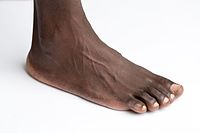
Photo from wikipedia
Background and purpose Identification of pathogens causing fracture-device-related infection (FDRI) is always a challenge as the positive rate of standard tissue sampling culture (TSC) remains unsatisfactory. This study evaluates the… Click to show full abstract
Background and purpose Identification of pathogens causing fracture-device-related infection (FDRI) is always a challenge as the positive rate of standard tissue sampling culture (TSC) remains unsatisfactory. This study evaluates the efficiency of implant surface culture (ISC) as an adjunct to standard TSC for identification of FDRI-associated microorganisms. Patients and methods Between November 2020 and March 2022, patients diagnosed with FDRI defined by the International Fracture-Related Infection (FRI) Consensus Group, and indicated for implant removal, underwent both methods for bacteria detection. The test order of ISC and TSC was randomly selected for each patient included, as a withinperson randomized design. For ISC, the recovered implants were gently covered with tryptic soy agar after rinsing with normal saline twice, and then incubated at 37℃ 5% CO2 for up to 14 days. For TSC, 5 specimens were sampled and sent to the Clinical Laboratory of Southern Medical University Nanfang Hospital, Guangzhou, for culture and identification. Results 42 consecutive patients were included, with a mean age of 46 years. The most frequent infection site and implant type were the tibia (21 cases) and plates with screws (30 cases), respectively. Altogether 21 patients were found with positive outcomes by both methods, and the identified pathogens were consistent. ISC found an additional 15 patients showing positive results, which were negative by TSC. Furthermore, the mean culture time of ISC was shorter than that of TSC (1.5 days vs. 3.2 days). Interpretation ISC may be a useful adjunct to TSC for detection of bacteria causing FDRI, with a relatively higher positive rate and a shorter culture time.
Journal Title: Acta Orthopaedica
Year Published: 2022
Link to full text (if available)
Share on Social Media: Sign Up to like & get
recommendations!